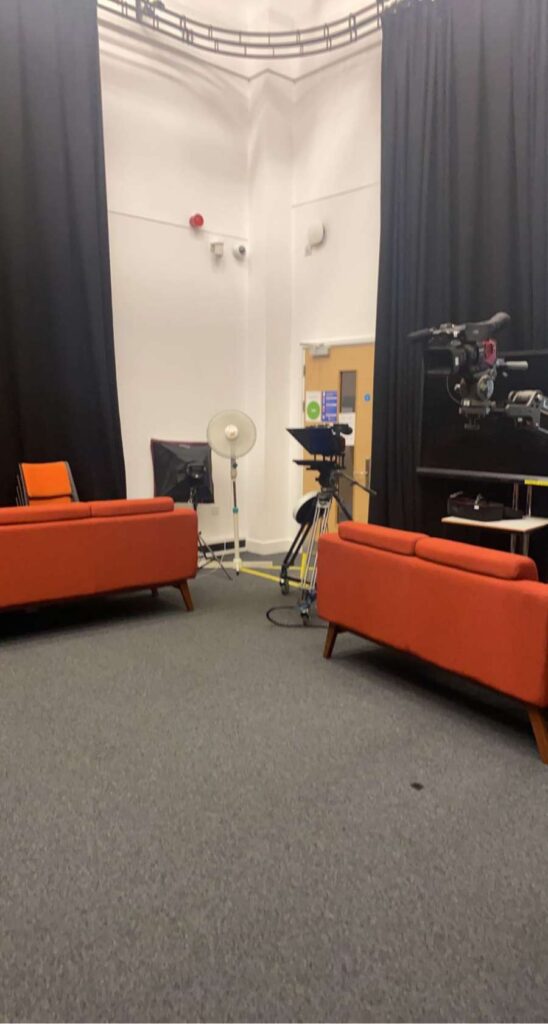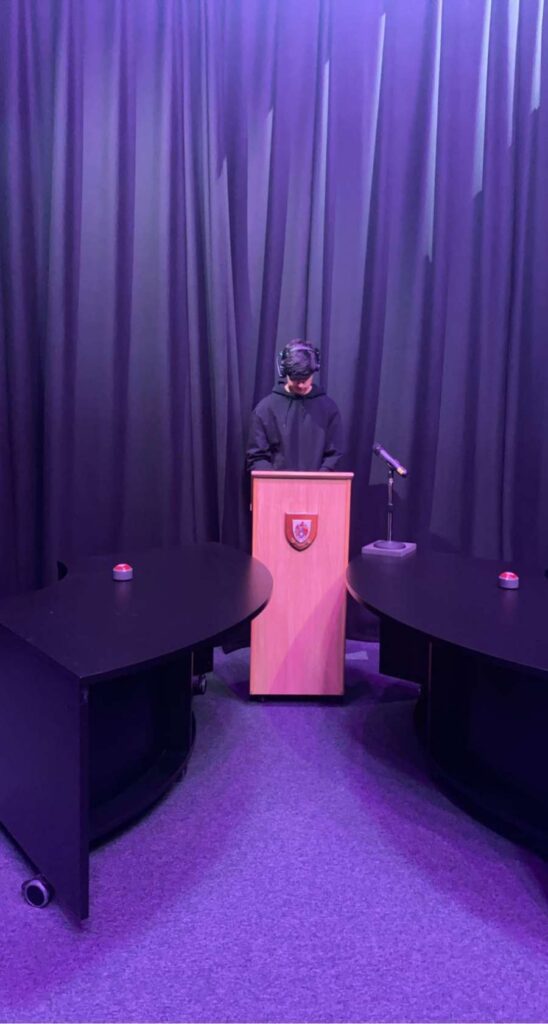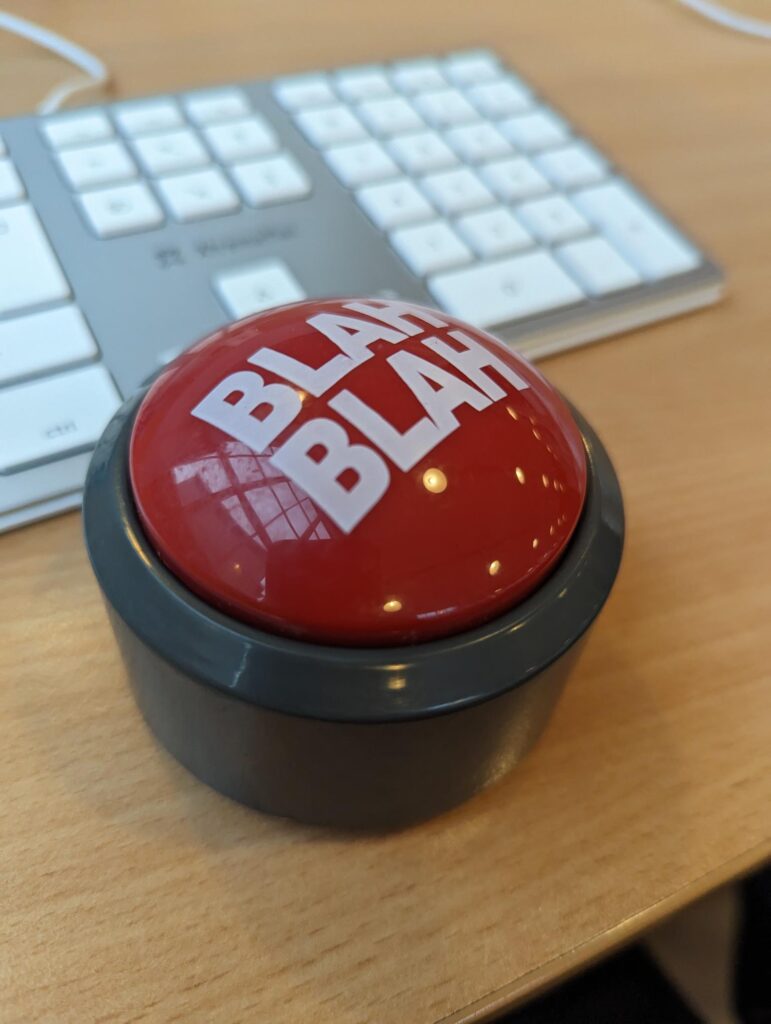
The groups we were initially assigned were changed leaving us to organise our own groups and come up with new ideas to try to be unique and stand out from any other group. We decided to split our show into segments making it more engaging to the audience and adding an extra layer of sophistication to our project. our first main segment is a game show which is inspired by games like “Who wants to be a millionaire” and “The Chase”.
Collins, P. (2023) Who wants to be a millionaire? (British game show), Wikipedia. Wikimedia Foundation. Available at: https://en.wikipedia.org/wiki/Who_Wants_to_Be_a_Millionaire%3F_(British_game_show) (Accessed: January 12, 2023).
“Who Wants to Be a Millionaire? is a British television quiz show, created by David Briggs, Steven Knight & Mike Whitehill for ITV. The programme’s format sees contestants taking on multiple-choice questions based upon general knowledge, winning a cash prize for each question they answer correctly, with the amount offered increasing as they take on more difficult questions. If an incorrect answer is given, the contestant will leave with whatever cash prize is guaranteed by the last safety net they have passed, unless they opt to walk away before answering the next question with the money the cash prize they had managed to reach. To assist in the quiz, contestants are given a series of “lifelines” to help answer question“
We plan to also have a social segment in which we venture into the outdoors and ask in the public entertaining, controversial and difficult questions. This is to keep our show alive and keep the viewers entertained with different viewpoints and opinions. This will be with a hand-held camera and a microphone in the public setting.

Hazards in the studio
– Be mindful of where the tables are
– Make sure to not sit on the desk to prevent it falling
– Be cautious with the crane (head injury and hand injury) make sure to not put your arm/hand in the middle of the crane.
The studio consists of three cameras
Number one being the camera on the far left that captures a diagonal shot across the set. Camera two is located on the either side of the set and you can angle these cameras down to achieve the shot you need. Camera three is the centre camera and encompasses the whole set, camera three is operated using a crane and can hover above the hosts and actors establishing the “wide shot”.

Lighting is extremely important as it adds to theme and ambience of whatever the project maybe. You can find these lights on the rack in the studio, they enable you to change them to any colour tint to whatever you see fit. A big part of making sure the whole project runs smoothly is the auto que. Someone will use the auto que at a specific speed and it can’t be too fast nor too slow.

CONTROL ROOM
The desk is where the light is controlled. You have your 3 colour panels and light points near the door and its best to stick with one colour. There’s an audio mixing desk to mute and unmute. The wall is soundproof and no one can be heard from either side, so in order to communicate the crew members have a headset where they can whisper into to talk to each other or follow orders. The Director, floor manager, camera men/women all have a headset in order to fulfil any tasks communicated to them. In the control room everyone heeds the director as they are in a position of authority. the floor manager however oversees the studio and has authority in commanding his fellow crew members. Although the floor manager still answers to the director, he is in charge with making sure the crew are all doing their jobs. Lastly the vision mixer is what’s on the programme and as its broadcasting it saves the footage the way it’s been edited. It’s used for focusing in on talent and making sure there is variation on who the audience are looking at when the colour red is emitted it means its live. Instead of using red you can use green which lines up what’s next it doesn’t affect the programme.
The purpose of scriptwriting is to create the main concept of your video production in written form. It provides a predetermined look at what will be said and what scenes will be shot to match the overall message you’re trying to portray. Your script will help you plan ahead as you prepare the many different aspects that will come together to make the final product.
An example of a script I really like is https://sites.google.com/site/tragedy160/game-show-script
The reason why I like this script is because it’s well formatted. I feel like it’s telling a story. This script always has a hook it’s something that keeps you guessing why this or that happened and what is going to happen next. It is well paced, constantly surprising, with sudden plot turns along with a satisfying and unpredictable ending. It’s key to have a person who drives the story forward, someone all can root for. All great scripts have them.
The script has snappy dialogue When a script is visual and entertaining, the dialogue is freed from having to explain any backstory or having to give context on what’s being said. It keeps the viewers on their Toes and makes it extremely interesting. Many writers work on their scripts within the draft, editing with their cursor, cutting, and pasting. But writing is different than deleting with a key.
Another reason that makes this script good is because all words are locked. It’s fully committed to every scene and line which If you read through your script and sense anything wobbly then you must hold back and continue to seek the best choice for your story.
script






In order to make sure I had the best cast possible for our gameshow we had to audition actors to decide who should have the opportunity to play the part of host. We auditioned two performing arts students however neither of them was able to memorise the lines effectively and as the director of the group I had to make a very important decision on whether I could risk having an actor who wouldn’t memorise the lines to play the part of host. In the end I came to a mutual agreement with my peers to place Omar who was a member of my group already, as the host. Omar is a reliable and punctual member of the group who I as a director, could trust would learn the dialogue that needed to be said. I used the two performing arts students who auditioned previously as contestants because they had less lines to learn and I didn’t have to rely on them being too committed to the roles they have.
I wrote the script by myself and managed to come up with a succinct chronological plot as to how the gameshow will be structured. In the script I tried to incorporate a lively and fun atmosphere in order to keep the audience entertained and interested. My goal was not to make the actors memorise the whole script word for word, however I wanted them improvise and make it their own because the nature of the show was light-hearted and quite relaxed.
For my vision (of how the project will look) to come to life I organised a designated time for the group to get together and create a floor plan. I wanted this floor plan to be specific and give the group insight on exactly how I wanted the set to look. So, I got the floor manager at the time whose name was Usman to do a rough sketch. We decided that the best way to make the set have the competitive spirit of the gameshow was to have the contestants facing each other in order to give the impression that they are going head-to-head. Throughout the game show the host is the most important and key figure because their job is to keep the show alive and running with no awkward pauses or anything with may hinder the overall enjoyment of watching the show. after considering the importance of the host I decided to place the podium where the host stands, in between the two contestants. This was a strategic move from my point of view as it symbolises the host literally being the centre of attention.


Whilst the rest of the group got their first shot to rehears their project idea on the Monday our group couldn’t get our chance because we had to audition actors to see who would be suitable enough to take part. Missing this valuable rehearsal time meant our group had a disadvantage and on top of this our original floor manager was kicked out of the course, leaving me with a tough decision to make. I had to decide who I would appoint as floor manager as a replacement which meant I had no one to work on camera one or two as I appointed the only cameraman, I had to take up the position. I appointed Abbas as the floor manager and we agreed he would have to work on all three cameras. It was a challenge however I was determined as the group leader to pull my group from the mud to a better place.
As my group is missing two people, I had to decide that camera one and two have to remain stationary facing both contestants. This is so the floor manager Abbas didn’t have the responsibility of having to move, centre and focus all three cameras constantly as this would be a heavy task that I didn’t want burden my team member with.


I researched lighting in a game show and what lighting is relevant in today’s live Tv. Game shows have a consistent theme of purple to red colour. I wanted to incorporate this into my game show as I wanted my game show to appear modern and relevant. The colour purple is used to spark creativity in the audience. I wanted to psychologically trick the audience into getting involved with the gameshow and its questions. To do this, the audience needed to engage with their “creative and fun” side, thus using the colour purple increased my chances of the viewers playing along.
My idea of having a public aid stemmed from trying to give the show a little boost in entertainment. Once I had come up with script ideas, I needed a way that i was going to incorporate something different to make my project stand out from a regular game show. So, I sat my group down and after a few minutes I had a light bulb moment and thought using the public would be cool, as it would show a level of sophistication and most likely boost our marks. I had to think about how the public aid would impact my show and what affect it would have on who wins. I then came up with the idea of the public having control over answering the questions that the contestants don’t know. I chose to give the public a lot of control over the outcome of the gameshow to add an aspect of unpredictability.
For the end prize that was going to be given, as a collective, we decided to create a form of money that was innovative and unique. Thats when my graphic designer/ vision mixer (Harley) came up with the idea of making a currency for our gameshow, where he designed a bank note with my face printed on it. This was a fun way to give the show something and custom to itself.

Music
Whilst planning for the gameshow we originally had ideas to put some sort of jolly backing track to give the game show some life. However whilst running rehearsals, we understood that it wasn’t realistic or practical as during the show, their were parts where the tone became more tense and parts in which it was light and fun. This meant that we would have-to change songs regularly to fit the atmosphere of whatever that specific section of the show had. Due to the lack of people in our group I couldn’t add that to bucket list of tasks that needed to be completed. Instead of having a backing track we decided to include souund affects for when the contestants got an answer wrong or right.
https://mixkit.co/free-sound-effects/game-show/
Every gameshow has a buzzer or a button for the contestants to press. So in order for our gameshow to be relevant and look normal I bought two buzzers for the contestants to use. I wanted them to be red in order to match the purple/red lighting we had. They originally came with sound that said “bla bla bla” which didn’t fit with overall theme of the gameshow. In order to tackle this issue I took the batteries out and included no sound for the buzzer.
